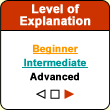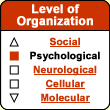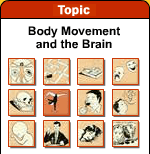|
|
|
|
 |
| Making
a Voluntary Movement |
 |
|
|
|

That mental imagery
can play a role in the learning of movements and the improvement
of motor performance is no longer questioned. Instead, the
latest research is attempting to identify the determinants
of efficient mental imaging. Studies have already shown that
people who are better at generating mental images make faster
progress in motor learning, as do people who practice a movement
physically before imagining it mentally. |
The concept of motor
imagery extends to the sensory modalities as well. When someone
has any given sensory experience, then re-imagines its later,
the brain activity in the two cases will be similar in both
location and intensity. Because brain activity continuously
influences the body, and vice versa, any experience has a
given effect on the body, and revisualizing it would generate
a similar pattern of brain activity with similar effects
on the endocrine system, the immune system, and so on.
Very generally speaking, visualization can therefore be regarded
as a form of autosuggestion or self-hypnosis which, by generating
emotions, may have a beneficial physiological effect on the
body. Much remains unknown about the precise mechanisms of
this interaction, but numerous studies of visualization have
demonstrated its actual physiological effects. |
|
|
| MENTAL IMAGING OF
BODY MOVEMENTS |
|
The most elaborate processes in human
psychic activity are made possible by mental entities that can
be substituted for real objects. Until the late 1970s, it was
thought that all information, regardless of sensory modality,
produced a mental representation in the brain that was independent
of this modality. Since it was thought that this representation
was merely an epiphenomenon, mental images were not considered
to play any functional role in the development of thought and
action. But subsequent experiments have shown that mental imagery
lies at the very heart of individuals' psychic lives. Indeed,
it interacts with all the other major cognitive systems, such
as visual perception, language, and memory.
But most important, research on mental imagery has shown that the
processes for actually producing a movement and for representing
it mentally are identical. Various experimental approaches have
been used to show, for example, that the mental representation
of an action seems to be based on the same mechanisms as the motor
preparation for it.
With mental
chronometry, for example, it has been shown that visual mental
images preserve the spatial and structural characteristics
of the of the object or scene that they represent. For example,
it has been shown that the visual travel time between two
points in a mental image of an object is proportional to
the distance between these two points on the actual object.
In another example, if you ask subjects either to pronounce
or to imagine pronouncing the alphabet or a series of whole
numbers as quickly as possible, the times for actually pronouncing
these sequences and for imagining pronouncing them are similar.
Parsons's experiments on mental rotation of objects led to
the same conclusion: the time it takes to rotate an object
mentally is proportional to the number of degrees of rotation
performed. For example, suppose that subjects are shown a photo
of a hand and are asked to decide whether it is a left hand
or a right one. They will take just as much time to make this
decision as to actually rotate their hand into the position
shown in the photo.The constant in the results of mental chronometry
experiments is thus the striking similarity in the durations
of actual actions and of actions represented mentally.
Researchers have also found some physiological indicators
whose activation resulted solely from mental imaging of actions.
For example, a group of researchers measured how physical
training and training by mental imaging affected the strength
of finger muscles. Physical training increased finger muscle
strength by 30%, but mental imaging alone still increased
it by 22%! Since the subjects did not make any muscle contractions
during their mental imagery training, the observed changes
did not come from the peripheral motor system but actually
came from the activation of circuits in the central motor
system.
Here is yet another example. When subjects were asked to
imagine walking or running at various speeds on a treadmill,
their heart rate and total ventilation increased in proportion
to the speed imagined in the course of this mental exercise,
even though their oxygen consumption remained steady. |
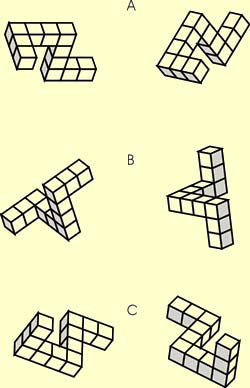
To determine whether the two
objects in each pair are the same, the subjects must rotate
and compare them mentally.
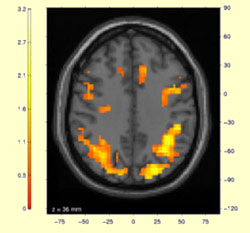
Areas of the brain activated
by mental rotation of objects
Source: University of Melbourne
Neuroimaging and Informatics
|
According
to the theory for which Swedish neurobiologist David Ingvar
coined the clever term "future memory", the parietal
cortex is capable of producing internal models of
movements to be performed, prior to any processing in the
premotor and motor cortexes. According to this theory, the
brain is constantly simulating movements, only some of which
are eventually externalized. This theory could provide a
conceptual foundation for the mental training done by athletes
and musicians, as well as for re-education through motor
imagery.
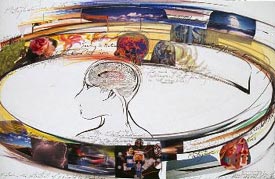
Source: Todd Siler

|
|
|

